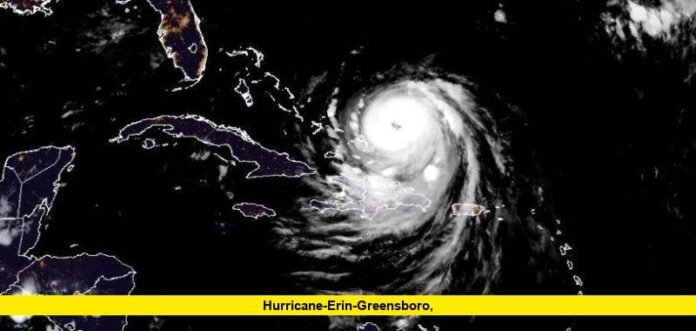Hurricane Erin Greensboro is currently a powerful Category 4 hurricane, intensifying rapidly as it approaches the U.S. East Coast. Forecasters warn that the Outer Banks of North Carolina are bracing for dangerous storm surges and damaging winds. Residents in Greensboro and surrounding areas are urged to stay alert as the storm’s impacts are expected to extend inland in the coming days.
Hurricane Erin gained strength overnight, with sustained winds reaching 130 mph, making it a significant threat, especially to coastal communities. The National Hurricane Center (NHC) reports that storm surge levels along the Outer Banks could exceed 7 feet, which raises concerns about coastal flooding and the potential for property damage.
Officials in Greensboro and other inland locations continue monitoring Hurricane Erin closely. Though Greensboro is miles inland, heavy rains and strong gusts are anticipated as the storm moves northward past the coast. Emergency management stresses the importance of preparation and caution.
Current Status and Latest Updates
- Category: 4 hurricane with winds at 130 mph
- Location: Approximately 100 miles southeast of the Outer Banks
- Movement: Northwest at 12 mph
- Storm Surge: Up to 7 feet expected along Outer Banks coast
- Rainfall: Up to 6 inches forecast inland including Greensboro area
Meteorologists highlight that hurricane-force winds are expanding, increasing the risk for power outages and structural damage inland. Flood watches are in effect for parts of North Carolina, including Greensboro, reflecting concern over intense rainfall causing flash floods.
What Greensboro Residents Should Expect
Although Greensboro is situated inland, the city is not immune to the storm’s effects. Expect:
- Periods of heavy rain leading to potential localized flooding
- Gusty winds capable of downing trees and power lines
- Possible disruption to travel and outdoor activities
Local authorities recommend securing loose outdoor objects and reviewing emergency kits. Residents should stay tuned to local updates and avoid unnecessary travel during peak storm conditions.
How the Outer Banks is Preparing
The coastal communities along the Outer Banks have declared states of emergency. Evacuation orders are in place for vulnerable low-lying areas. Emergency shelters have been opened, and resources are being deployed for rapid response to flood and wind damage.
The combination of rising tide and hurricane-driven surge could lead to significant beach erosion and road closures. Residents are urged to heed evacuation warnings seriously.
Expert Insights and Precautions
Experts remind that hurricanes of this intensity can cause widespread destruction, but timely action saves lives. Key safety tips include:
- Following evacuation orders promptly
- Avoiding flooded areas and downed power lines
- Keeping cell phones and flashlights charged
- Listening to official advisories via radio or trusted online platforms
Officials also encourage that neighbors check on elderly or vulnerable individuals during the storm.
As Hurricane Erin Greensboro continues to pose a serious threat to North Carolina’s coast and inland communities, staying informed and prepared remains crucial. Share your experiences or questions below, and keep monitoring official sources for updates as the situation evolves.
